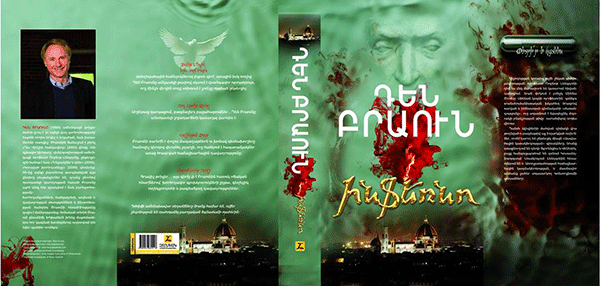Under the initiative of “Zangak” publishing, the novel of an American writer Dan Brown’s “Inferno” was issued in Armenian, which was translated by translator, poet and literary critic Vahe Arsen. The book, translated into 52 languages and printed in 19 million copies until now had become No. 1 bestseller of the USA TODAY in its publication year 2013. Note that Brown was known for his novel “Da Vinci Code” (2003), which has also become a bestseller with multi-million circulation in 2004 and 2006. The protagonist of this novel, an American professor in symbolic studies, Robert Langdon, whom the reader knows from the novels “Angels and Demons” (2000), “The Lost Symbol” (2009), will meet in the “Inferno” too. The characters of the book follow a horrifying message of the scientist obsessed with persistent ideas of salvation of the planet and humanity.
The American professor and his inventive companion are in frantic searches in Florence, Venice and Istanbul. Are the efforts futile…The novel depicts a constant escape and search. The reader faces Dante Alighieri’s hell from time to time – Inferno, and not only in the lines of the “Divine comedy” serving as passwords but also in the canvases of the greatest painters of Renaissance. “Because of my tight schedule in recent years, I have very little time or desire to read long novels, but this book attracted me so much that I read it in two days,” says the translator Aram Topchyan.
The translator distinguishes three “abilities” of Dan Brown, thanks to which, according to him, the novels of this writer have such a great success. “The first one is the ability to create a strong and intriguing plot and immediately attracting the reader, taking it to the end. Secondly, he is able to connect the strong plots of his novels with remarkable monument of art and literature, and he does it with such brilliant esthete and simple and accessible means that the ordinary reader immediately obtains great interest towards these monuments. It is no coincidence that not people in the world have started to read “The Divine Comedy” or to study the art of Renaissance. And finally, the third ability is his never-ending imagination.”
Evaluating the Armenian translation of “Inferno”, Aram Topchyan said that he has the impression that the novel was written just in Armenian because the translation is done in a very nice and fluent Armenian. The translation for translator Vahe Arsen was not so easy, moreover, the translation of the “Inferno” turned into a hell for me, a real inferno,” says V. Arsen. The reason is not the linguistic peculiarities and compound structures of Brown and the detailed descriptions of other names and various architectural structures and their particles, particularly since many of them do not exist in our architecture, and he had to invent relevant words to present them. On the other hand, the passwords and ambiguities related to various sciences, philosophies and artistic works…
As estimated by literary critic Hayk Hambardzumyan, the “Inferno” has a very interesting plot: fast-growing, bonded and so on. We can find many elements of both detective, thriller and mystic. “But for me, perhaps, the most important thing is that the novel reminds us again of the genius of Renaissance, Dante and his immortal work “Divine Comedy” (“Inferno” is translated as hell, and the first part of “Divine Comedy” is called just as it is – “Hell”).
“Inferno” is again taking us back to this century and calls the humanity to vigilance. The “Divine Comedy” also has the same goal. It calls humanity to vigilance and morality, it is trying to show the right way so that people will eventually be able to get rid of the sins so that the whole earth would live a life more in harmony. The secret of the immortality of “Divine Comedy” is here. It speaks about eternal realities. Dan Brown’s novel leads us to Dante, to the art of the medieval Renaissance. And, of course, the focal point laid in the novel is very important, which is also quite topical today in the world. And it is the overflow of the population in the planet, which, according to the author, will result in the lack of resources, which in its turn will result in the disruption of relationships between people. The earth, eventually, will turn into a hell, if this is not prevented. But there is a question here. How to prevent? Whom to choose to save? This question remains pending. The evil genius, one of the characters, solves this question for himself, but the other characters are still hesitating. They do not know. And the reader cannot find the answer to this question for him. This is a very serious question, whom to save, whom to leave, to choose or not to choose,” analyzes the literary critic.
According to Vahe Arsen, Dan Brown is a great master of creating images. And “Inferno” is richer in images than the author’s previous novels. “He seems like writing a movie rather than a script, but the very movie. You read and visualize what you read, you appear in Florence and begin equally struggling with the characters,” says the translator of the book. According to him, “Inferno” is Brown’s best work. “I do not know whether Dan Brown will be able to write such a novel one more time… It seems like he grew and grew and reached the peak. He completed. All his novels are completed in “Inferno”… The end of the novel is very interesting. Unexpected. I am certain that no reader will be able to guess the end when starting to read the book. To tell the truth, I did not expect such a good dénouement from Dan Brown,” says Vahe Arsen half-jokingly and half-serious.
Siranush HAYRAPETYAN

























































